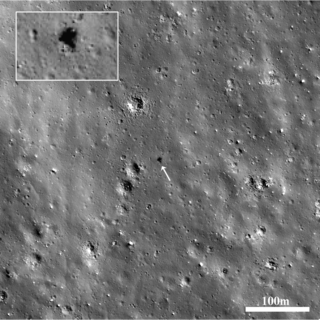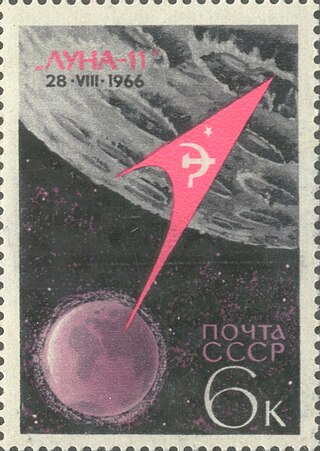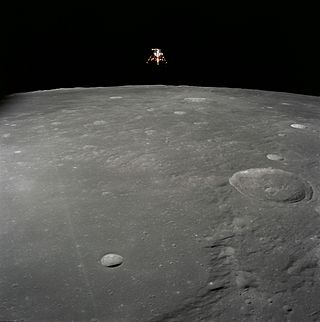
Lunokhod was a series of Soviet robotic lunar rovers designed to land on the Moon between 1969 and 1977. Lunokhod 1 was the first roving remote-controlled robot to land on an extraterrestrial body.

The Surveyor program was a NASA program that, from June 1966 through January 1968, sent seven robotic spacecraft to the surface of the Moon. Its primary goal was to demonstrate the feasibility of soft landings on the Moon. The Surveyor craft were the first American spacecraft to achieve soft landing on an extraterrestrial body. The missions called for the craft to travel directly to the Moon on an impact trajectory, a journey that lasted 63 to 65 hours, and ended with a deceleration of just over three minutes to a soft landing.

Surveyor 7 was sent to the Moon in 1968 on a scientific and photographic mission as the seventh and last lunar lander of the American uncrewed Surveyor program. With two previous unsuccessful missions in the Surveyor series, and with Surveyor 7's landing success, Surveyor 7 became the fifth and final spacecraft in the series to achieve a lunar soft landing. A total of 21,091 pictures were transmitted from Surveyor 7 back to Earth.

Luna 4, or E-6 No.4, sometimes known in the West as Lunik 4, was a Soviet spacecraft launched as part of the Luna program to attempt the first soft landing on the Moon. Following a successful launch, the spacecraft failed to perform a course correction and as a result it missed the Moon, remaining instead in Earth orbit before possibly transitioning into a solar orbit. Though the mission was unsuccessful, it nevertheless marked a new epoch in the Space Race, which culminated in the successful landing of Luna 9 in 1966.

Surveyor 1 was the first lunar soft-lander in the uncrewed Surveyor program of the National Aeronautics and Space Administration. This lunar soft-lander gathered data about the lunar surface that would be needed for the crewed Apollo Moon landings that began in 1969. The successful soft landing of Surveyor 1 on the Ocean of Storms was the first by an American space probe on any extraterrestrial body, occurring on the first attempt and just four months after the first soft Moon landing by the Soviet Union's Luna 9 probe.

The Luna programme, occasionally called Lunik by western media, was a series of robotic spacecraft missions sent to the Moon by the Soviet Union between 1959 and 1976. The programme accomplished many firsts in space exploration, including first flyby of the Moon, first impact of the Moon and first photos of the far side of the Moon. Each mission was designed as either an orbiter or lander. They also performed many experiments, studying the Moon's chemical composition, gravity, temperature, and radiation.

Luna 9 (Луна-9), internal designation Ye-6 No.13, was an uncrewed space mission of the Soviet Union's Luna programme. On 3 February 1966, the Luna 9 spacecraft became the first spacecraft to achieve a soft landing on the Moon and return imagery from its surface.

Luna 11 was an uncrewed space mission of the Soviet Union's Luna program. It was also called Lunik 11. Luna 11 was launched towards the Moon onboard a Molniya-M and entered lunar orbit on 27 August 1966.
Luna 12 was an uncrewed space mission of the Luna program, also called Lunik 12.

Luna 16 was an uncrewed 1970 space mission, part of the Soviet Luna program. It was the first robotic probe to land on the Moon and return a sample of lunar soil to Earth. The 101 grams sample was returned from Mare Fecunditatis. It represented the first successful lunar sample return mission by the Soviet Union and was the third lunar sample return mission overall.

Luna 17 was an uncrewed space mission of the Luna program, also called Lunik 17. It deployed the first robotic rover onto the surface of the Moon.

Luna 23 was an uncrewed space mission of the Luna program developed by the Soviet Union.

Luna 24 was a robotic probe of the Soviet Union's Luna programme. The 24th mission of the Luna series of spacecraft, the mission of the Luna 24 probe was the third Soviet mission to return lunar soil samples from the Moon. The probe landed in Mare Crisium. The mission returned 170.1 g (6.00 oz) of lunar samples to the Earth on 22 August 1976.

Surveyor 2 was to be the second lunar lander in the uncrewed American Surveyor program to explore the Moon. After launch on September 20, 1966 a mid-course correction failure resulted in the spacecraft losing control. Contact was lost with the spacecraft at 9:35 UTC, September 22.

Mars 3 was a robotic space probe of the Soviet Mars program, launched May 28, 1971, nine days after its twin spacecraft Mars 2. The probes were identical robotic spacecraft launched by Proton-K rockets with a Blok D upper stage, each consisting of an orbiter and an attached lander.

A lander is a spacecraft that descends towards, then comes to rest on the surface of an astronomical body other than Earth. In contrast to an impact probe, which makes a hard landing that damages or destroys the probe upon reaching the surface, a lander makes a soft landing after which the probe remains functional.

The 1966 Lunar Orbiter 1 robotic spacecraft mission, part of NASA's Lunar Orbiter program, was the first American spacecraft to orbit the Moon. It was designed primarily to photograph smooth areas of the lunar surface for selection and verification of safe landing sites for the Surveyor and Apollo missions. It was also equipped to collect selenodetic, radiation intensity, and micrometeoroid impact data.

A Moon landing or lunar landing is the arrival of a spacecraft on the surface of the Moon, including both crewed and robotic missions. The first human-made object to touch the Moon was Luna 2 in 1959.

A lunar lander or Moon lander is a spacecraft designed to land on the surface of the Moon. As of 2024, the Apollo Lunar Module is the only lunar lander to have ever been used in human spaceflight, completing six lunar landings from 1969 to 1972 during the United States' Apollo Program. Several robotic landers have reached the surface, and some have returned samples to Earth.

The physical exploration of the Moon began when Luna 2, a space probe launched by the Soviet Union, made a deliberate impact on the surface of the Moon on September 14, 1959. Prior to that the only available means of lunar exploration had been observations from Earth. The invention of the optical telescope brought about the first leap in the quality of lunar observations. Galileo Galilei is generally credited as the first person to use a telescope for astronomical purposes, having made his own telescope in 1609, the mountains and craters on the lunar surface were among his first observations using it.


















